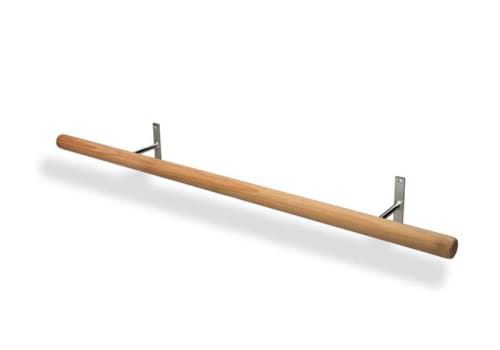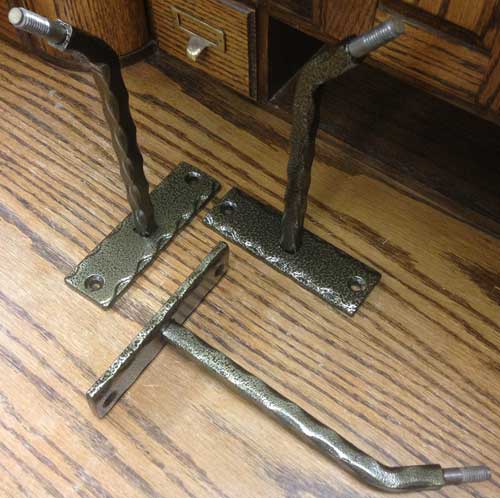Wall-mounted barres should be anchored to wood studs or wall blocking. Brackets are supplied complete with screws and can be mounted at any height: four fixings for the single bracket and six fixings for the double bracket. Barres are set at 8 1/4″ (21cm) from the wall to the center of the barre.
One of the most familiar elements in any dance studio is a ballet barre. When you are first starting out as a dance studio manager, you might not yet have one. However, you will need to install a permanent one or acquire a portable one soon. Preferably before your doors ever open. With that in mind, below are some important things to keep consider when it comes to installing a ballet barre in your studio.
5ft Wall Mounted Ballet Barre. This wall-mounted barre is the perfect size to fit into the room of anyone trying to improve their flexibility or any dancer, even great for studio use! Being a wall-mounted barre, this allows it to be placed at any height needed while being long enough to accomplish any stretch or exercise. Harlequin professional ballet barres compliment any dance studio or rehearsal space. Ballet barres are an essential tool for warm-up and stretching exercises, allowing increased blood flow to the muscles, improving flexibility and lessening the risk of injury before taking to the dance floor. Inside: Make a wall-mounted wood ballet barre in this easy step-by-step tutorial. Bend, squat, kick and dipas long as you can do all that you have space to install a ballet barre in your home. If you don’t have a home gym you can put it in a bedroom, office or in a laundry room and have it double a.
Why You Need A Ballet Barre
Before we get to the steps you need to take when installing a ballet barre and the factors to consider, let’s discuss briefly why you need a ballet barre in the first place. You might be thinking – we don’t teach ballet at our dance studio, can’t we just skip installing one?

Yes, you could, but we wouldn’t recommend it. The reason for this is that including barre exercises in your dance classes promotes strength and endurance, and improves flexibility and posture for your students. Barre exercises work the abs, arms, legs, and back, and strengthens these muscles to be able to endure a wide variety of movements in all types of dance.
The stretches performed during barre exercises help your students to stay flexible and move gracefully through their dances as well. Stretching in barre exercises also helps relieve pain and tension that may be in the joints of the body, making the body better able to withstand grueling rehearsals and long spans of instruction time. And, students that perform barre exercises often, will be amazed at how they can hold tough positions better, and longer each time they attend class.
Steps For Installing a Ballet Barre
Now that you understand why you need a ballet barre and to include barre exercises regardless of the classes you teach, we can move on to the steps for ballet barre installation.
- Decide on the type of barre you want – portable or wall-mounted, and a wooden or metal barre
- Gather the necessary materials
- Build or install the barre
- Celebrate and begin using it
Alright. We admit that it’s not this cut and dry. So let’s break this down further so you can choose the perfect barre for your dance studio.
First, consider whether you want a portable ballet barre or one that is wall-mounted.
Believe it or not, the type of barre you choose matters. Is one better than the other? The most simple answer to this complicated question is that it depends. The truth is there are pros and cons to both types of ballet barres.
Portable Ballet Barres
Double Ballet Barre Wall Mount
Pros:
- Because a portable barre is a freestanding one, students can stand on both sides of it to perform their exercises, making it more efficient to use if you have large class attendance.
- You can move it to any room that needs it.
- Let’s say you’re having an open house and need additional barre for demonstrations or instructions. The flexibility to move the barre to another room could be helpful.
- Portable barres are much more affordable than wall-mounted ones – we’re talking as much as one-quarter of the cost of wall-mounted barres depending on the type you get.
- Because of this low price, many studios are able to get multiple barres in various heights to accommodate younger and shorter students, as well as older and taller ones.
- Many portable barres are adjustable in height. This can help when you have children in a class at 5 p.m., but adults in the 8:30 p.m. class in the same room.
Cons:
- The first time setting up a portable ballet barre can be quite difficult. And, if you plan on setting it up and taking it down often, this means you will have to endure the tricky set up and break down each time.
- If not properly installed, some dancers complain it doesn’t give optimum support to their legs while performing stretches and routines.
- In other words, it might be easier for someone to get hurt with a portable barre. This lack of support and instability can be dangerous for your studio. One accident could close your dance studio doors.
Wall-Mounted Ballet Barres
Pros:

- You only need to install it once. Because wall-mounted barres are permanently affixed to the wall, you won’t have to worry about setting up the next time you have a class. It’s already done – always.
- They are significantly more durable, making it the better choice for weight-bearing exercises and routines.
- When properly installed, they are considered much safer and more stable than portable ones.
Cons:
You can only use one side of it because on the other side is the wall. Therefore, if you have too many students for the one wall-mounted barre, you may need to install another, and you only have so many walls in a studio that can be used for this. For example, one of your walls is likely already taken by a floor to ceiling mirror (and if it’s not, it should be).
Other cons:


- It’s fixed to the wall, so if another class needs to use it and you only have one barre in one room of your studio, the students that need the barre will need to be moved to that room.
- Wall-mounted barres are significantly more expensive than portable ones by as much as four times the cost.
- Don’t forget the installation fee when tallying up your cost too. You’ll need to pay the pros to install it for safety and liability reasons. This is one time it’s best not to try and DIY the project. Improper installation could result in injuries that could cost you big fines, or even worse.
- Because it’s fixed on the wall, once you choose the height for it to be installed, that is the height it will be permanently.
- Of course, you could choose to install what is known as a double barre, meaning it has two different heights. This might provide a happy medium to accommodate both shorter and taller students with just one barre.
Additional things to consider if you choose a wall-mounted barre:
Have your materials ready ahead of installation time. Before you can proceed with the installation, you’ll need to make sure you have all the materials gathered for your installation crew. As well as, have your area prepped, for example, if you need to paint the wall(s) before installation, make sure you do that at least a day or two ahead of time. (Save some paint for touch-ups after installation in case of scratches or missed drill holes.)
Ballet Barre Brackets Wall Mounting
Being prepared will save a lot of time and effort rather than going back and forth to the home improvement store. You’ll also need wall brackets and screws, as well as the barres themselves.
The number of brackets required will depend on how many barres you plan to install. Brackets are typically pre-paired with screws. It is also recommended you buy wall anchors for added stability if the wall does not have a stud that you’ll be drilling into.
There are some companies that sell barre kits with all the pieces you may need, but be sure to check and count those pieces before calling in your installation crew. It’s better to over-prepare than risk delays and added fees.
Choose the Height
The barre should come to the waist level for the average height of an adult. If you’re installing one barre and not a double barre, it should be approximately 42-44 inches from the floor for an adult. And 32-34 inches from the floor for children. If you only service young adults and adults, however, many studios can get by with one single barre installed at 32-46 inches from the floor.
Ballet Barre Wall Mount

Ballet Barre Wall Mount Diy
A double barre is considered a much better investment if your dance studio serves both children and young adults. With a double barre, the upper barre accommodates young adults and adults, and the lower barre accommodates children.
However, should you need a barre installed even lower to the floor than this, it might be a good idea to get a portable barre as well. In fact, it might be best to get one that has an adjustable height. Children grow like weeds, and the height they need at the beginning of the class season compared with the middle or end of the season could actually change drastically.
The barre should be spaced far enough away from the wall. Assuming your barre is roughly 1.75 inches in diameter, from the inside of the barre to the wall, there should be approximately 7.25 inches. From the outside of the barre to the wall should be approximately 9 inches.
Adjustable Ballet Barre Wall Mounted
Raise the Barre With Your Studio
We know there are already so many decisions swimming in your head with opening a dance studio. Hopefully, this post made your choice of at least your ballet barre installation a little easier. With a little planning and the right tools, your studio can certainly raise the barre and be more successful in no time.
Ballet Wall Bars Horizontal Bar
3601 Walnut St Suite 410
Denver, CO 80205
Phone: 1-877-688-3870
Email:info@thestudiodirector.com
